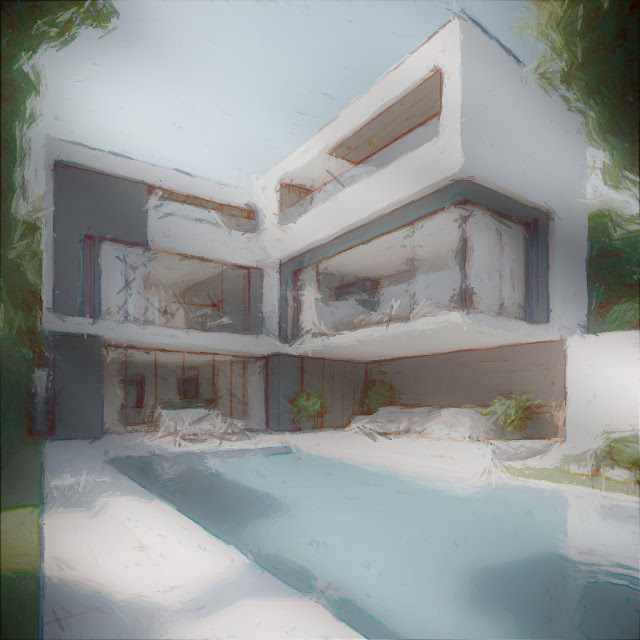Introduction
Amorphous forms, characterized by their fluid, organic shapes and lack of defined geometry, represent a departure from traditional architectural conventions. Inspired by nature and driven by advancements in computational design and digital fabrication, architects are increasingly embracing amorphous forms to create visually stunning and conceptually innovative architectural compositions. This article delves into the realm of amorphous forms in architecture, exploring their design principles, aesthetic appeal, and transformative potential in redefining the built environment.
Defining Amorphous Forms
Amorphous forms, also known as organic or fluid forms, defy rigid geometric principles and instead embrace fluidity, curvature, and irregularity. Unlike rectilinear or modular forms, amorphous forms lack distinct boundaries and exhibit a sense of continuous flow and dynamic movement. These forms often draw inspiration from natural phenomena such as clouds, water, and organic structures, seeking to emulate the fluidity and complexity found in the natural world.
Design Principles of Amorphous Forms
Several design principles inform the creation of amorphous forms in architecture:
1. Biomorphic Design: Amorphous forms often take cues from biological organisms and natural systems, adopting organic shapes and biomorphic aesthetics. This biomimetic approach seeks to blur the boundaries between architecture and nature, creating buildings that resonate with their environment and evoke a sense of organic growth and vitality.
2. Computational Design: Advances in computational design tools and parametric modeling enable architects to explore complex geometries and iteratively refine amorphous forms through algorithmic processes. Computational design algorithms allow for precise control over form generation, enabling architects to manipulate parameters such as curvature, density, and continuity to achieve desired spatial qualities.
3. Digital Fabrication: Amorphous forms are often realized through digital fabrication technologies such as 3D printing, CNC milling, and robotic fabrication. These technologies enable architects to translate digital design models into physical prototypes with unprecedented precision and complexity, facilitating the realization of intricate and sculptural architectural forms.
Aesthetic Appeal and Expressive Potential
Amorphous forms in architecture offer a range of aesthetic and expressive qualities:
1. Sculptural Elegance: Amorphous forms possess a sculptural elegance that captivates the eye and engages the senses. Their fluid contours and dynamic profiles create visually compelling architectural compositions that invite exploration and contemplation.
2. Spatial Fluidity: Amorphous forms imbue architectural spaces with a sense of fluidity and movement, challenging conventional notions of enclosure and boundary. Spaces defined by amorphous forms flow seamlessly from one to another, blurring distinctions between interior and exterior, solid and void.
3. Expressive Freedom: Amorphous forms afford architects a degree of expressive freedom and creative exploration that transcends traditional architectural constraints. By liberating design from strict geometric rules, amorphous forms open up new possibilities for architectural expression and experimentation.
Applications and Case Studies
Amorphous forms find applications across various architectural typologies and contexts:
1. Cultural Institutions: Cultural institutions such as museums, galleries, and performing arts centers often embrace amorphous forms to create iconic and expressive architectural landmarks. Examples include the Guggenheim Museum Bilbao by Frank Gehry, with its undulating titanium-clad facade, and the Walt Disney Concert Hall in Los Angeles, characterized by its sculptural stainless steel surfaces.
2. Public Spaces: Amorphous forms are used to design public spaces and urban interventions that engage the public and foster social interaction. The Serpentine Pavilion in London, an annual architectural commission featuring temporary pavilions designed by renowned architects, often showcases experimental amorphous forms that redefine the boundaries of architectural space.
3. Commercial and Retail Spaces: Commercial and retail spaces leverage amorphous forms to create immersive and experiential environments that captivate customers and enhance brand identity. The Apple Store in Istanbul, designed by Foster + Partners, features a striking amorphous glass canopy that envelops the store's entrance, creating a dynamic and inviting entryway.
Challenges and Considerations
Despite their aesthetic appeal and expressive potential, amorphous forms present challenges in terms of construction, engineering, and maintenance. Structural stability, material selection, and fabrication complexity are among the considerations architects must address when designing with amorphous forms. Additionally, the long-term durability and maintenance requirements of amorphous architectural elements may pose logistical challenges that warrant careful planning and coordination.
Conclusion
Amorphous forms in architecture represent a bold departure from traditional design paradigms, offering architects a canvas for creativity, experimentation, and expression. By embracing fluidity, curvature, and organic complexity, amorphous forms challenge conventional notions of form and space, inviting viewers to experience architecture in new and transformative ways. As architects continue to push the boundaries of design innovation, amorphous forms will undoubtedly play a pivotal role in shaping the architectural landscape of the future, blurring the lines between art, technology, and nature.



























No comments:
Post a Comment